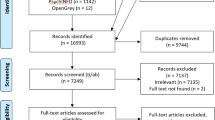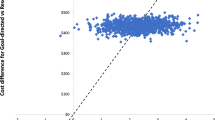Abstract
Objectives:
To examine whether a weight loss program delivered to one spouse has beneficial effects on the untreated spouse and the home environment.
Methods:
We assessed untreated spouses of participants in three sites of Look AHEAD, a multicenter randomized controlled trial evaluating the impact of intentional weight loss on cardiovascular outcomes in overweight individuals with type 2 diabetes. Participants and spouses (n=357 pairs) were weighed and completed measures of diet and physical activity at 0 and 12 months. Spouses completed household food and exercise environment inventories. We examined differences between spouses of participants assigned to the intensive lifestyle intervention (ILI) or to the enhanced usual care (DSE; diabetes support and education).
Results:
Spouses of ILI participants lost −2.2±4.5 kg vs −0.2±3.3 kg in spouses of DSE participants (P<0.001). In addition, more ILI spouses lost ⩾5% of their body weight than DSE spouses (26 vs 9%, P<0.001). Spouses of ILI participants also had greater reductions in reported energy intake (P=0.007) and percent of energy from fat (P=0.012) than DSE spouses. Spouse weight loss was associated with participant weight loss (P<0.001) and decreases in high-fat foods in the home (P=0.05).
Conclusion:
The reach of behavioral weight loss treatment can extend to a spouse, suggesting that social networks can be utilized to promote the spread of weight loss, thus creating a ripple effect.
This is a preview of subscription content, access via your institution
Access options
Subscribe to this journal
Receive 12 print issues and online access
$259.00 per year
only $21.58 per issue
Buy this article
- Purchase on SpringerLink
- Instant access to full article PDF
Prices may be subject to local taxes which are calculated during checkout

Similar content being viewed by others
References
Jacobson P, Torgerson JS, Sjöström L, Bouchard C . Spouse resemblance in body mass index: effects on adult obesity prevalence in the offspring generation. Am J Epidemiol 2007; 166: 101–108.
Katzmarzyk PT, Hebebrand J, Bouchard C . Spousal resemblance in the Canadian population: implications for the obesity epidemic. Int J Obes Relat Metab Disord 2002; 26: 241–246.
Macken LC, Yates B, Blancher S . Concordance of risk factors in female spouses of male patients with coronary heart disease. J Cardiopulm Rehabil 2000; 20: 361–368.
Maes HM, Neale MC, Eaves LJ . Genetic and environmental factors in relative body weight and human adiposity. Behav Genet 1997; 27: 325–351.
Jeffery RW, Rick AM . Cross-sectional and longitudinal associations between body mass index and marriage related factors. Obes Res 2002; 10: 809–815.
Kahn HS, Williamson DF . The contributions of income, education and changing marital status to weight change among US men. Int J Obes 1990; 14: 1057–1068.
Sobal J, Rauschenbach B, Frongillo EA . Marital status changes and body weight changes: a US longitudinal analysis. Soc Sci Med 2003; 56: 1543–1545.
Katzmarzyk PT, Perusse L, Rao DC, Bouchard C . Spousal resemblance and risk of 7-year increases in obesity and central adiposity in the Canadian population. Obes Res 1999; 7: 545–551.
Christakis NA, Fowler JH . The spread of obesity in a large social network over 32 years. N Engl J Med 2007; 357: 370–379.
Hur YM, Bouchard TJ, Eckert E . Genetic and environmental influences on self-reported diet: a reared-apart twin study. Physiol Behav 1998; 64: 629–636.
Patterson RE, Kristal AR, Shannon J, Hunt JR, White E . Using a brief household food inventory as an environmental indicator of individual dietary practices. Am J Public Health 1997; 87: 272–275.
Newmark-Sztainer D, Wall M, Perry C, Story M . Correlates of fruit and vegetable intake among adolescents. Findings from Project EAT. Prev Med 2003; 37: 198–208.
Zabinki MF, Daly T, Norman GJ, Rupp JW, Calfas KJ, Sallis JF et al. Psychosocial correlates of fruit and vegetable, and dietary fat intake among adolescent boys and girls. J Am Diet Assoc 2006; 106: 814–821.
Jakicic JM, Wing RR, Butler BA, Jeffery RW . The relationship between presence of exercise equipment in the home and physical activity level. Am J Health Promot 1997; 11: 363–365.
Wing RR, Gorin AA, Tate DF . Strategies for changing eating and exercise behavior. In: Bowman BA, Russell RM (eds). Present Knowledge in Nutrition. 9th edn. ILSI Press: Washington, DC, 2006. pp 822–837.
Sexton M, Bross D, Hebel JR, Schumann BC, Gerace TA, Lasser N et al. Risk-factor changes in wives with husbands at high risk of coronary heart disease (CHD). J Behav Med 1987; 10: 251–261.
Shattuck AL, White E, Kristal AR . How women's adopted low-fat diets affect their husbands. Am J Public Health 1992; 82: 1244–1250.
White E, Hurlich M, Thompson RS, Woods MN, Henderson MM, Urban N et al. Dietary changes among husbands of participants in a low-fat dietary intervention. Am J Prev Med 1991; 7: 319–325.
Zimmerman RS, Gerace TA, Smith JC, Benezra J . The effects of a worksite health promotion program on the wives of fire fighters. Soc Sci Med 1988; 26: 537–543.
Ryan DH, Espeland MA, Foster GD, Haffner SM, Hubbard VS, Johnson KC, et al., Look AHEAD Research Group. Look AHEAD (Action for Health in Diabetes): design and methods for a clinical trial of weight loss for the prevention of cardiovascular disease in type 2 diabetes. Control Clin Trials 2003; 24: 610–628.
The Diabetes Prevention Program. Design and methods for a clinical trial in the prevention of type 2 diabetes. Diabetes Care 1997; 22: 623–634.
Wadden TA, West DS, Delahanty L, Jakicic J, Rejeski J, Williamson D, et al., Look AHEAD Research Group. The Look AHEAD study: a description of the lifestyle intervention and the evidence supporting it. Obesity 2006; 14: 737–752.
Block G, Woods M, Potosky A, Clifford C . Validation of a self-administered diet history questionnaire design using multiple diet records. J Clin Epidemiol 1990; 43: 1327–1335.
Paffenbarger RS, Wing AL, Hyde RT . Physical activity as an index of heart attack risk in college alumni. Am J Epidemiol 1978; 108: 161–175.
Raynor HA, Polley BA, Wing RR, Jeffery RW . Is dietary fat intake related to liking or household availability of high- and low-fat foods? Obes Res 2004; 12: 816–823.
Block G, Hartman AM, Naughton D . A reduced dietary questionnaire: development and validation. Epidemiol 1990; 1: 58–64.
Pi-Sunyer X, Blackburn G, Brancati FL, Bray GA, Bright R, Clark JM, et al., The Look AHEAD Research Group. Reduction in weight and cardiovascular disease risk factors in individuals with type 2 diabetes: one-year results of the Look AHEAD trial. Diabetes Care 2007; 30: 1374–1383.
Campbell KJ, Crawford DA, Salmon J, Carver A, Garnett SP, Baur LA . Associations between the home food environment and obesity promoting eating behaviors in adolescence. Obesity 2007; 15: 719–730.
Hanson NI, Neumark-Sztainer D, Eisenberg ME, Story M, Wall M . Associations between parental report of the home food environment and adolescent intake of fruits, vegetables, and dairy foods. Public Health Nutr 2005; 8: 77–85.
Ebbeling CB, Feldman HA, Osganian SK, Chomitz VR, Ellenbogen SJ, Ludwig DS . Effects of decreasing sugar-sweetened beverage consumption on body weight in adolescents: a randomized, controlled pilot study. Pediatrics 2006; 117: 673–680.
Gorin AA, Raynor HA, Niemeier HM, Wing RR . Home grocery delivery improves the household food environments of behavioral weight loss participants: results of an 8-week pilot study. Int J Beh Nutr Phys Act 2007; 4: 58.
Jeffery RW, Wing RR, Thorson C, Burton LR . Strengthening behavioral interventions for weight loss: a randomized trial of food provision and monetary incentives. J Consult Clin Psychol 1993; 6: 1038–1045.
Wing RR, Jeffery RW, Burton LR, Thorson C, Nissinoff KS, Baxter JE . Food provision vs structured meal plans in the behavioral treatment of obesity. Int J Obes Relat Metab Disord 1996; 20: 56–62.
Acknowledgements
This ancillary study was supported by the National Institute of Nursing Research NR07960. The parent trial was supported by the Department of Health and Human Services through the following cooperative agreements from the National Institutes of Health: DK57136, DK57149, DK56990, DK57177, DK57171, DK57151, DK57182, DK57131, DK57002, DK57078, DK57154, DK57178, DK57219, DK57008, DK57135 and DK56992. The following federal agencies also contributed support National Institute of Diabetes and Digestive and Kidney Diseases; National Heart, Lung, and Blood Institute; National Institute of Nursing Research; National Center on Minority Health and Health Disparities; Office of Research on Women's Health and the Centers for Disease Control and Prevention. This research was supported in part by the Intramural Research Program of the National Institute of Diabetes and Digestive and Kidney Diseases. All researchers are independent of the funding agencies.The study represents the collective efforts of the Home Environment Research Group (noted below) as well as the Look AHEAD Research Group. The full list of acknowledgments has been previously published in the Look AHEAD 1-year result paper.
Home Environment Research Group
The Miriam Hospital/Brown Medical School: Renee Bright, MS (Program coordinator); Vincent Pera, MD (Co-investigator); Deborah Tate, PhD (Co-investigator); Kara Gallagher, PhD (Co-investigator); Amy Bach, PhD; Barbara Bancroft, RN, MS; Anna Bertorelli, MBA, RD; Richard Carey, BS; Tatum Charron, BS; Heather Chenot, MS; Kimberley Chula-Maguire, MS; Pamela Coward, MS, RD; Lisa Cronkite, BS; Julie Currin, MD; Maureen Daly, RN; Caitlin Egan, MS; Erica Ferguson, BS, RD; Linda Foss, MPH; Jennifer Gauvin, BS; Don Kieffer, PhD; Lauren Lessard, BS; Deborah Maier, MS; JP Massaro, BS; Tammy Monk, MS; Rob Nicholson, PhD; Erin Patterson, BS; Suzanne Phelan, PhD; Hollie Raynor, PhD, RD; Douglas Raynor, PhD; Natalie Robinson, MS, RD; Deborah Robles; Jane Tavares, BS.
The University of Alabama at Birmingham: Cora E Lewis, MD, MSPH (Principal investigator); Sheikilya Thomas MPH (Program coordinator); Monika Safford, MD (Co-investigator); Charlotte Bragg, MS, RD, LD; Amy Dobelstein; Stacey Gilbert, MPH; Stephen Glasser, MD; Sara Hannum, MA; Anne Hubbell, MS; Jennifer Jones, MA; DeLavallade Lee; Ruth Luketic, MA, MBA, MPH; Karen Marshall; L. Christie Oden; Janet Raines, MS; Cathy Roche, RN, BSN; Janet Truman; Nita Webb, MA; Audrey Wrenn, MAEd.
University of Minnesota: Carolyn Thorson, CCRP (Program coordinator); John P Bantle, MD (Co-investigator); J Bruce Redmon, MD (Co-investigator); Richard S Crow, MD (Co-investigator); Scott Crow, MD (Co-investigator); Susan K Raatz, PhD, RD (Co-investigator); Carolyne Campbell; Jeanne Carls, MEd; Tara Carmean-Mihm, BA; Emily Finch, MA; Anna Fox, MA; Elizabeth Hoelscher, MPH, RD, CHES; La Donna James; Vicki A Maddy, BS, RD; Therese Ockenden, RN; Birgitta I. Rice, MS, RPh CHES; Tricia Skarphol, BS; Ann D Tucker, BA; Mary Susan Voeller, BA; Cara Walcheck, BS, RD
Look AHEAD staffs are listed alphabetically by site.
Author information
Authors and Affiliations
Consortia
Corresponding author
Rights and permissions
About this article
Cite this article
Gorin, A., Wing, R., Fava, J. et al. Weight loss treatment influences untreated spouses and the home environment: evidence of a ripple effect. Int J Obes 32, 1678–1684 (2008). https://doi.org/10.1038/ijo.2008.150
Received:
Revised:
Accepted:
Published:
Issue Date:
DOI: https://doi.org/10.1038/ijo.2008.150



